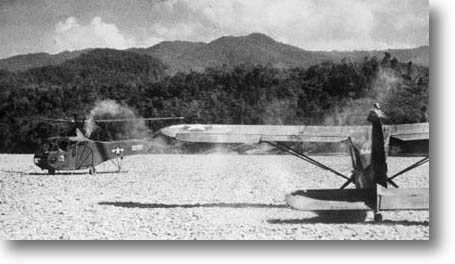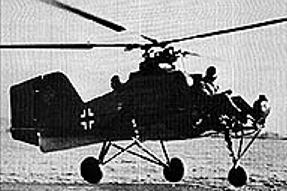Off-topic: A sketch of Cornu’s helicopter:

Back on topic 
There was operational use of helos in WWII…
U.S.A. …YR-4

On January 17, 1945, a priority radio stating that a helicopter was urgently needed to rescue a group of American fliers who had been forced down in Burma was sent from Eastern Air Command Headquarters in India to Army Air Forces Headquarters in Washington, D.C. It reached Washington the same day. On January 26th, only 9 days later, the helicopter had completed the rescue of a wounded enlisted man from the top of an isolated mountain in North Burma. In the interim, the aircraft had been dismantled at Wright Field, Dayton, Ohio; loaded, together with trained helicopter personnel, into a C-54 of the Air Transport Command; carried half way around the world to Myitkyina, Burma; reassembled and flown over jungles and 5,000-foot Peaks to accomplish its mission.
from this site…
http://www.helis.com/stories/burma45.php
Germany…Flettner FL 282 Kolibri

In this pic, the twin rotor-heads with the vertical shafts angled to the sides, and the twin countra-rotating rotors can clearly be seen…
_overhead.jpg)
In 1940, Hitler 's Kriegsmarine (German Navy) made a request for a naval helicopter for operate from its units. Derivative from the Flettner FL 265, the FL 282 deliveries begun in 1942 and the next year, 20 prototypes were in service. The model demonstrate to be very effective so plans for 1000 units where approved but being a Navy aircraft had little claim on production facilities and they were finally aborted due allied bombs to the BMW and Flettner factories. 32 preproduction aircraft were delivered, and three were taken home as war booty by Russia and the United States.Engine: 1 radial engine Bramo Sh 14A of 7 cylinders with 160 hp
Speed: : 150 km/h
Service Ceiling: 3300 m
Range: 170 kmWeight: Empty: 760 kg – Max: 1000
Width: 25.55 m
Length: 6.56 m
Height: 2.20 m
Rotor Span: 11.96 m
Disc Area: 224 m2 each

Freidrich Doblhoff began work on a jet (gas drive) helo in 1942 at the Weiner Neustadter Flugzeugwerke in Vienna with official backing. 4 prototypes of the Doblhoff WNF 342, as it was designated, were built between 1942-45.
A conventional piston engine drove a compressor to compress air. This air was mixed with fuel and delivered to the rotor tips where it was burnt in a small combustion chamber. The engine powered a propellor and the gas drive jet tipped rotor was used for take offs and landings. The 4th prototype, WNF V-4, had a 132HP engine driving the compressor from an Argus As 411 engine and weighed in at 1,410 lbs with a rotor diameter or 32.5 feet
